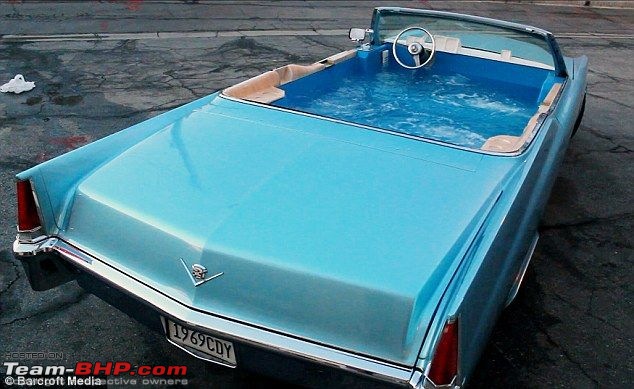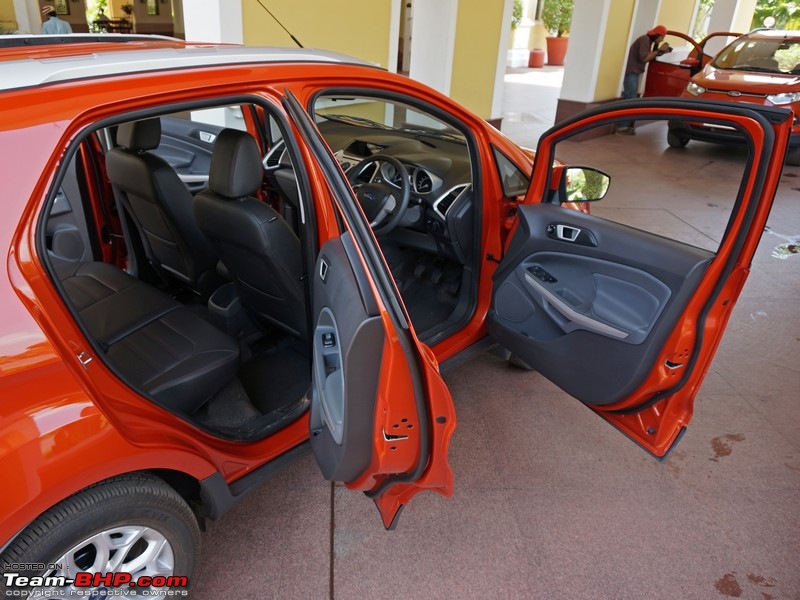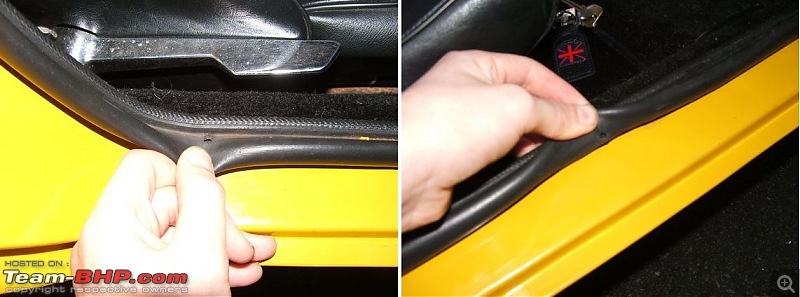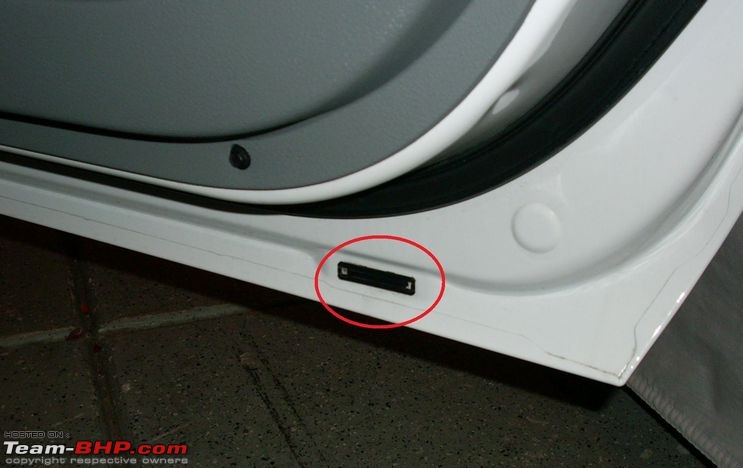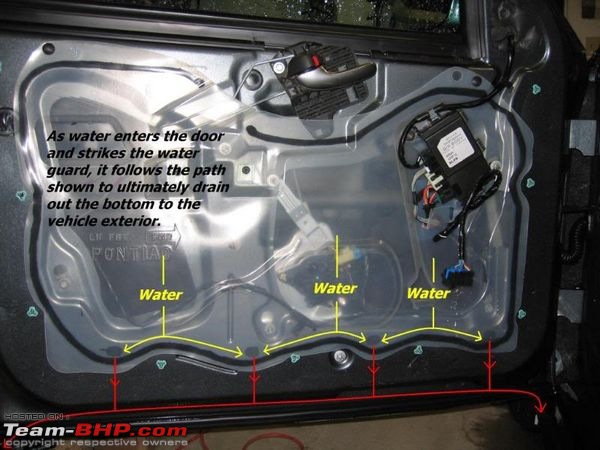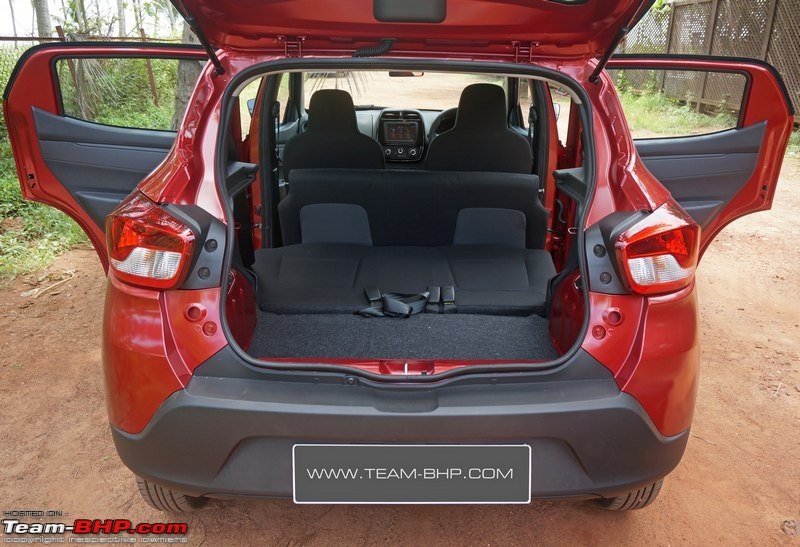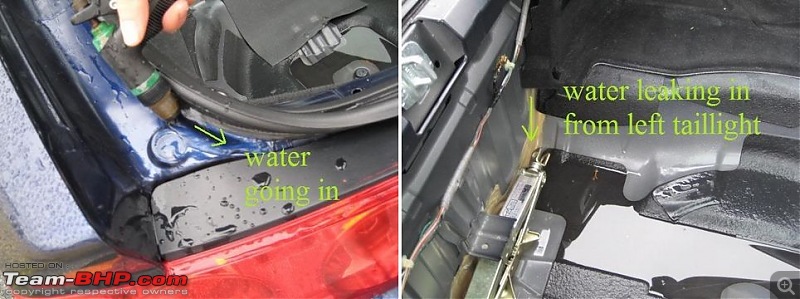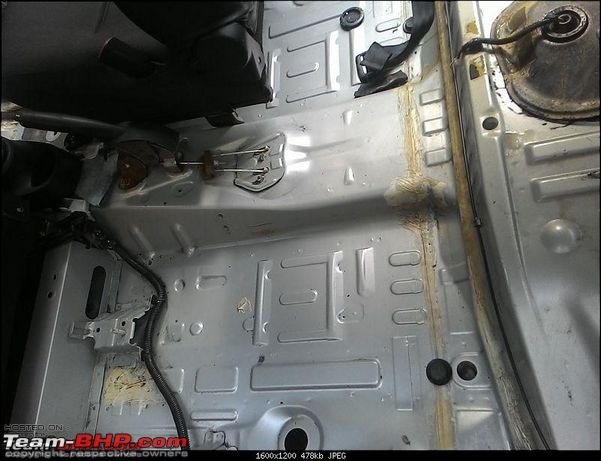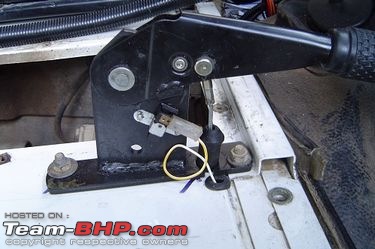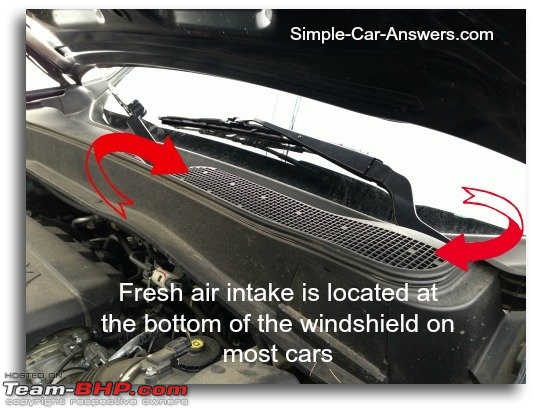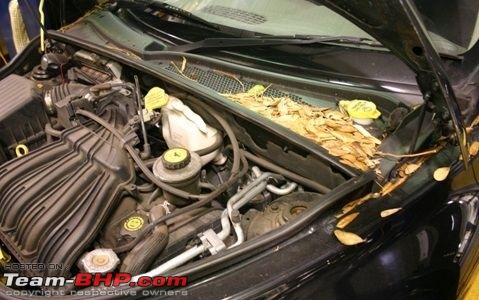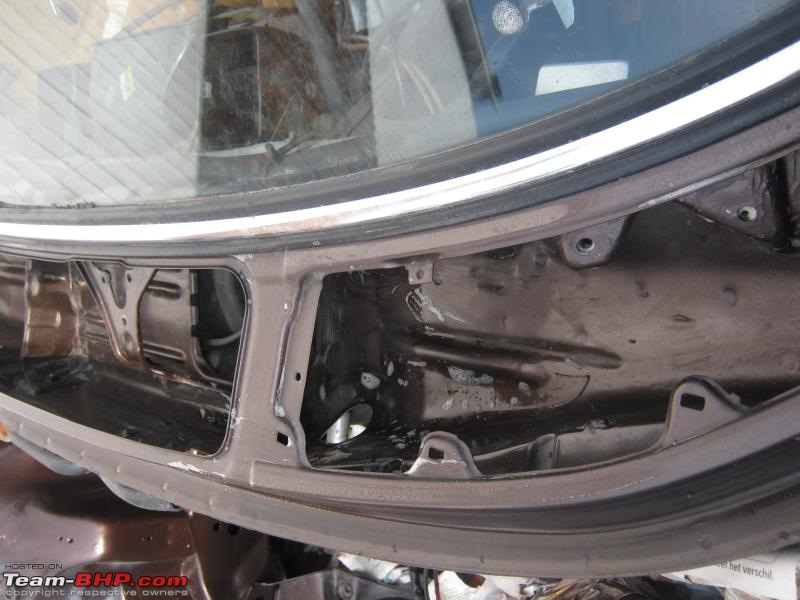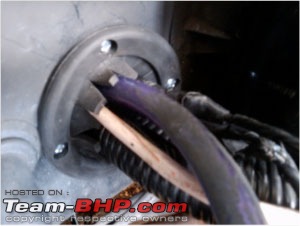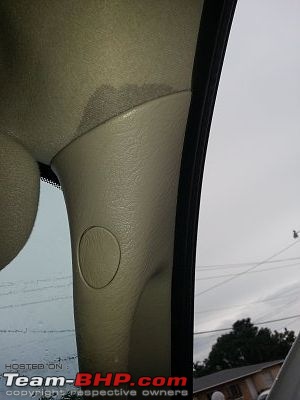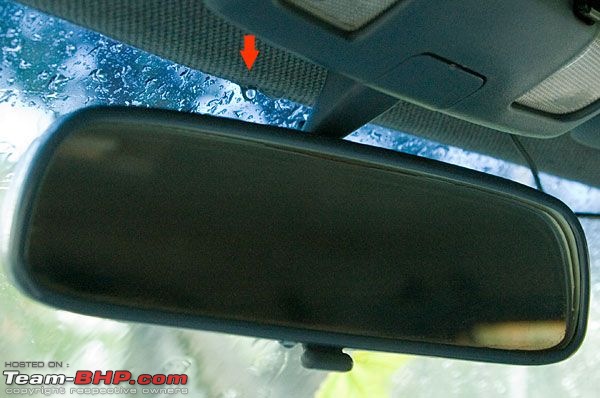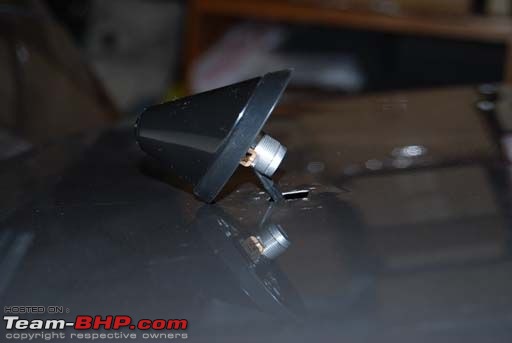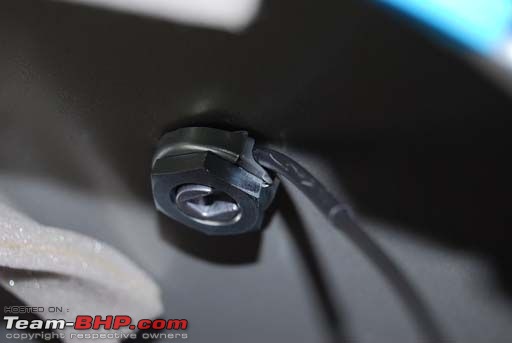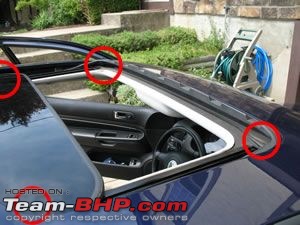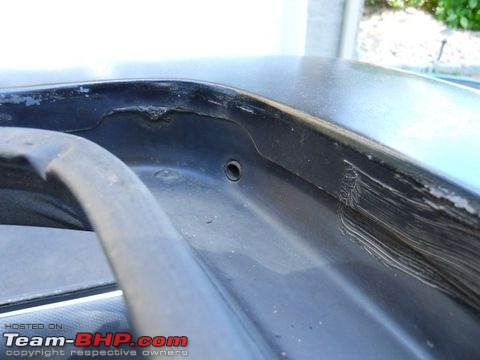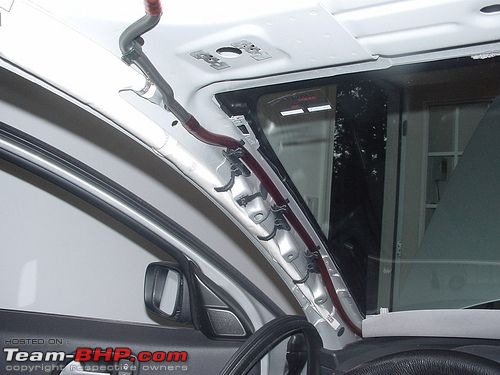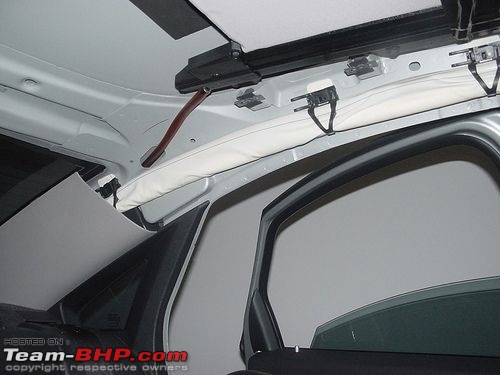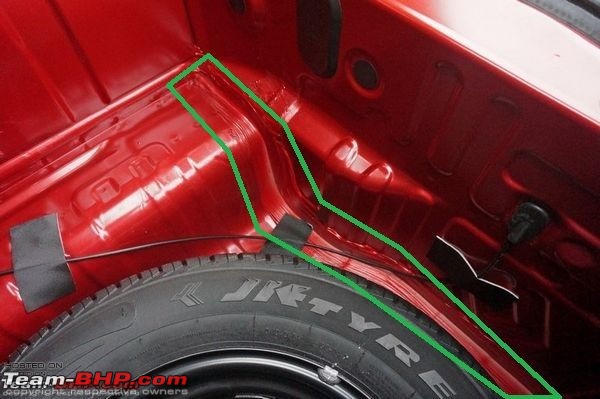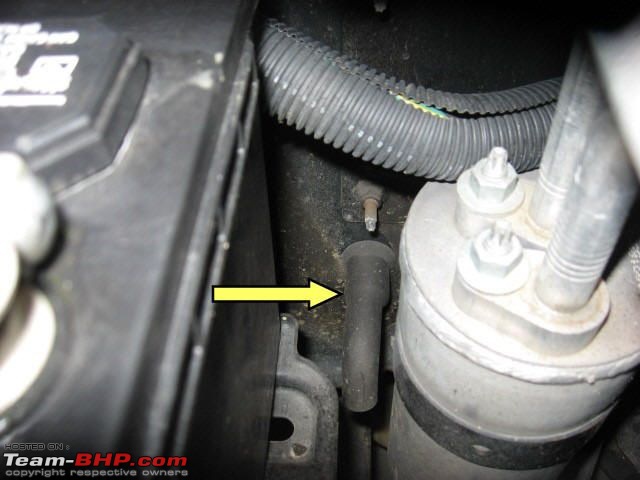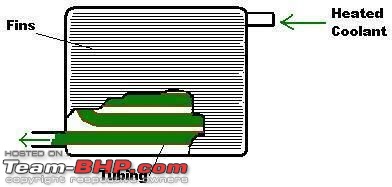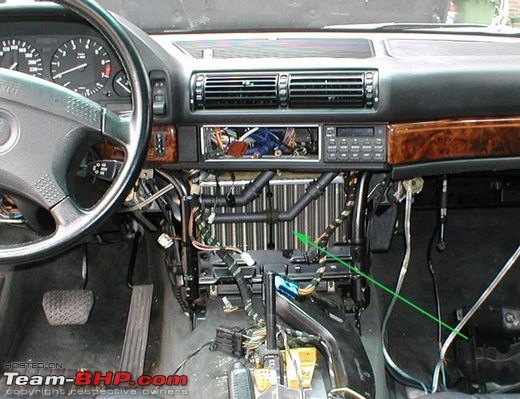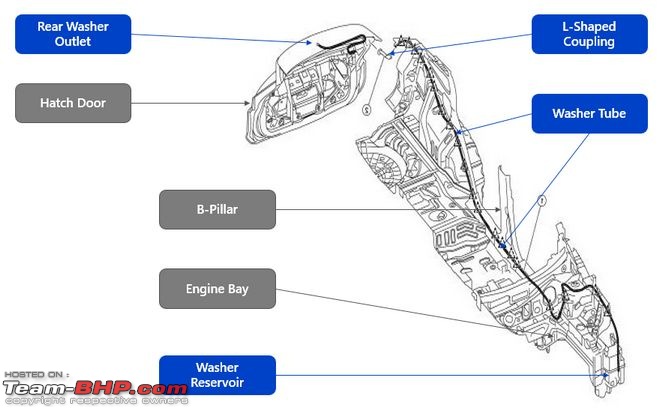| |||||||
| Search Forums |
| Advanced Search |
| Go to Page... |
 |
| Search this Thread |  225,559 views |
| | #1 | |
| Distinguished - BHPian  | Water Leakage in cars - Causes & solutions Quote:
Hmm, that's not quite what I had in mind when I thought of 'water in cars'. Water leakage into a car can also have physical effects - the interior of a car consists of various absorbent material which can easily absorb and hold water for long periods of time. And in turn, that can cause bad odour, fungus/mould formation, and rusting of metal. Not to mention the plethora of electronics present that can be damaged. And, its just icky having to place your feet on sodden floor mats. The Purpose of This Thread In this thread, I will aim to illustrate the various things that can cause water to enter a car, with some information on how to diagnose and fix them. I will not go into detail of how to fix the issues yourself, so its not a DIY. You will most likely need a service center/garage to do some of the work, due to the need for specific tools, parts, or just the ability to access areas like the firewall. Typical authorized service centers usually don't like to spend much time on diagnosing leaks, because the fixes are usually simple and cheap, and are not commensurate with the time spent on diagnosis. Furthermore, the difficulty of reproducing a leak means that its easy for them to hand-wave and dismiss the problem. However, armed with the information in this thread, you should be able to better diagnose on your own where the leak might be happening, and also better monitor and question the people who work on your car when fixing it, and possibly even direct them towards certain areas they might ignore! I'll first list out the different areas you can commonly find water inside a car, and give a list of possible entry points for water. After that, we will look at each of those entry points in detail. Areas with Water, and Potential Entry Points Below is a list of areas you might find water inside a car, and where the water could have possibly entered from. While the water might spread around the car, its useful to first isolate where the water has accumulated the most, since that will indicate the origin. This can be done visually, or by pressing the carpet with your finger to see how much water is squeezed out. Once you have a handle on the origin of the water's entry point, that makes diagnosis that much easier. A disclaimer: this is not (and cannot be) a 100% exhaustive list, but aims to cover the majority of common causes. I'm not listing the commonest cause - which is leaving a door ajar, or a window cracked open (you might not even see the gap, but the manual window winder will have a little more of a rotation to go). Water in Front Passenger Footwell
Water in Front Footwell (Either Side)
Water in any Footwell (Front / Rear, Either Side)
Water in Boot / Spare Tire Area
Water on Dashboard, or inside the Windshield
Headliner is soaked
Now that we've mapped the areas with water to possible entry points, let's look at each of those areas in some more detail. Last edited by arunphilip : 11th September 2016 at 19:11. Reason: Adding images | |
| |  (33)
Thanks (33)
Thanks
 |
| The following 33 BHPians Thank arunphilip for this useful post: | Ashir, basubhatta, Bibendum90949, blackbandit, dark.knight, dr. sen, Dr.AD, Gannu_1, GKMahajan, gpa, GTO, hmansari, InControl, johy, lambuhere1, libranof1987, McLaren Rulez, Moto_Hill, paragsachania, RavenAvi, samaspire, Samba, Simhi, SmartCat, SS-Traveller, sukiwa, Tgo, The Rationalist, Thermodynamics, uab55, vb-saan, VijayAnand1, Wildy |
| |
| | #2 |
| Distinguished - BHPian  | Entry Points for Water into a Car Entry Points for Water into a Car The following images show the various areas where water can commonly enter the passenger compartment or boot of a car. Although the image is that of a 3-box sedan, the same is applicable to hatchbacks, SUVs, crossovers, etc. 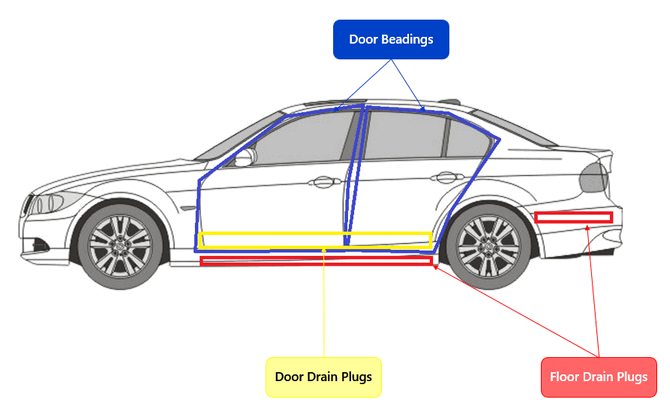 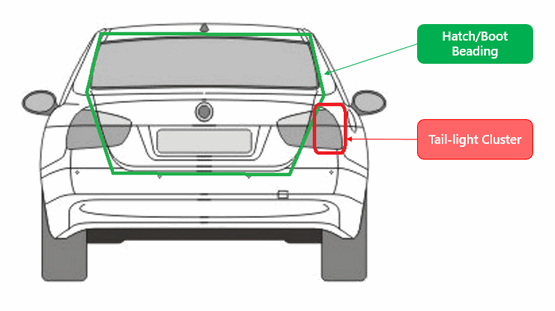 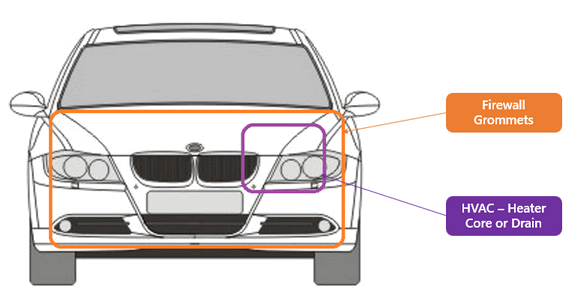 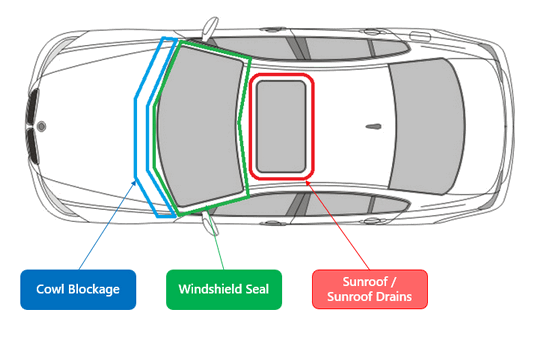 Unedited grayscale car outline courtesy of bimmerpost.com/bestcarlive.com Door Beading The door beading provides a seal between the moveable doors, and the immobile door frame. The beading usually consists of rubber tubes (called a bulb) that are squeezed between the door and frame when shut to provide a seal. This beading can be either on the door frame, the door itself, or both. The beading ensures that rain water that enters from the door openings on the top and sides of the car are correctly routed around the beading and guided to the bottom, where it can drain out onto the rocker panel (i.e. the flat door sill at the bottom). This seal formed by the beading might not be effective at times, resulting in water entering. This could be due to an ill-fitting beading, a cracked/torn beading, or a beading that has become too stiff with age, and does not expand to fill the gap entirely. These beadings are cheap, and can be replaced quite easily. If you've ever had your car's value assessed by a valuator, then double-check your beadings. The valuator will often pull the beading away to check if the car has the spot welds from the company, or if it has been subsequently re-welded as part of an accident repair. In such cases, double check to ensure the beadings have been fitted back and are seated properly, and were not damaged during the examination. Also, the beading on the door frame can become loosened or damaged at the bottom due to passenger's feet. If you examine a beading closely, you'll find small holes in it - these holes serve a very important purpose. When water droplets are collected by the beading, they will run from around the beading and collect at the bottom. These holes allow the water to drain onto the outside of the rocker panel and exit the vehicle. If these holes are not present or are blocked, then the water will accumulate on the other side of the beading until it spills into the car. You can test to see if the beading is the source of the leak by directing low pressure water from a hose (not pressurized from a car washer) or a mug of water around the door beadings to check if water droplets are observed inside. Door Drain This might come as a surprise, but the doors in our cars have tiny drains built in to the lower edge of them. This is to ensure that any water that enters the door (e.g. by sliding down the window) has an exit path and does not accumulate within the door itself (which can be felt by a sloshing sound when moving the door). Ensure that these drains are clear of any obstructions like mud, twigs, small leaves. If required gently clean them with a wire, taking care not to damage any surrounding items (e.g. puncturing rubber, scratching paint). Boot/Hatch Beading For the most part, the boot beading (for a sedan) or hatch beading (for a hatchback) is similar to the beading of the other doors. Once again, the beading ensures that rain water that enters from the hatch openings on the top and sides of the car are correctly routed around the beading and guided to the bottom, where it can drain out onto the bumper. Taillights Based on how the taillight is fitted, it could also prove a point of entry for water. This could either be around the taillight assembly itself (if a gasket is used for sealing), or via the grommet for the wiring. If you look at the preceding picture for the boot beading, you'll notice that the taillight assembly is right in the path of the water that drains around the beading. This is why it is important that the taillight gasket (if one is present) or the wiring grommet is properly seated and is in good shape. If you've had a taillight replaced recently, check to see that it is seated correctly - often, mud/leaves accumulate around the taillight, and if this is not cleaned out when a new taillight is fitted, it can cause water to enter. Also, when the taillight is changed, it is preferable that a new grommet is used for routing its wiring, since the older one would be worn, and might have torn or been damaged as part of the installation. You can check for leaks around the taillight again using a hose to direct the water, similar to what is shown in the above picture. Floor Pan The floor of the car is called the floor pan. This has holes in it, which are blocked by drain plugs or grommets in normal use. It is possible that one of these plugs is dislodged, resulting in water from the road being swept up or splashed up into the car. The following picture shows the circular holes and the plugs removed and placed next to the drain holes. An examination of the floor of the car (either from inside after removing the carpet, or from underneath) will determine if there are any missing, dislodged or damaged drain plugs that need replacement. Replacing or fitting the drain plugs will require the removal of the fitted floor carpet. If you've had any work done on the handbrake, then the handbrake grommet is also to be checked. Cowl Blockage/Fresh Air Intake The fresh air intake of a HVAC brings in fresh air from outside the car into the passenger compartment. This fresh air intake is fed from the cowl/cowling that is found at the base of the windshield (it is the black plastic strip with holes in it). The cowl plays two "conflicting" roles - it needs to let the water from the windshield drain away, and it needs to provide a way for fresh air to enter. You can see how things can go wrong here! Normally, the cowl allows water to drain away on either side of the cowl through specific drain channels or gutters that usually flow into or near the wheel wells. If the cowl is clogged, it can result in water accumulating, and then flowing into the fresh air intake of the AC system. The seals in this fresh air intake are designed for air and dust, so water will overwhelm them and flow into the passenger footwell. The clogging can be caused by leaves/twigs accumulating in the cowl area (particularly a problem for people who park outside), or even just mud in the gutters. Apart from removing the visible items on the cowl, it might also require the cowl itself to be removed (by taking out a couple of screws, and possibly the wiper blades) and then cleaning the drain channels below the cowl using running water to ensure they are also not closed. Bear in mind that if you've had this problem, it is good to inspect and possibly replace the fresh air filter in the car AC system. If this filter was waterlogged at some point, it could be harbouring fungus, which is not good news. Firewall Grommets/Plugs The firewall is the vertical metal wall that separates the passenger compartment from the engine compartment. It is an important part of a car's crash structure. However, the firewall has several openings in it due to the various items that need to pass between both compartments, such as wires, HVAC hoses, steering and pedal linkages. Further, some firewalls may have additional holes in them for features not in use (e.g. international models might have holes on both sides for the steering/pedal linkages). These holes are plugged with either plugs (which fully closes the hole) or grommets (which allow wires/hoses/links to pass through). If these plugs or grommets are damaged, dislodged or missing, they can result in water entering the front footwells. One of the common causes of grommet problems is amplifier installation. When installing an amp, the installer usually directly taps 12V from the battery and runs a dedicated wire from the battery to the amplifier, which is stored in the passenger compartment or boot. This wire passes through the firewall. Depending on the manner of installation, this can cause problems with the grommet. Likewise, if there has been a repair that entailed working around the firewall (e.g. AC evaporator replacement) it is good to double check the grommets if leaks are encountered. Accessing some areas of the firewall is easier done from below the car. Trying to replicate a water leak in the firewall is tricky, since the water that enters is often water that is picked up on the move. So this might require some persistence. Windshield Seal The windshield is sealed against the frame using a urethane sealant. If the sealant is either incomplete or is not level, it can provide an entry point for water. Depending on where the leak is, it will manifest itself either as water in the front of the headliner, on the inside of the A-pillars, in the footwell, or even on the inside of the windshield! This is most often observed after a windshield replacement, and is a sign that the windshield is not fitted correctly (although it is not unheard of in new cars). It is best to get it corrected by the service center or windshield specialists. Bear in mind that the windshield contributes to the structure of the car, so its essential that the windshield is fitted correctly. Also, don't attempt any home remedies using silicone sealant - while it may seal the gap, it does not provide any adhesive strength. Roof Attachments The roof of a car is pierced by a few openings - most notably for the antenna, but also for things like roof racks (load carrying ones, not the ornamental roof rails), etc. Like the firewall, there are seals and gaskets used to prevent water entry, and if these are loose or cracked, can result in water entering via the roof and onto the headliner. So, if you're planning on doing a DIY to fit a smart-looking shark-fin antenna, take care that you use all the relevant gaskets, and don't damage any existing ones in the process. This is usually fixed by replacing the relevant gaskets/plugs. Sunroof Drain Ah, sunroofs and water leaks. I mean, we've got a great big hole cut out in the roof of a car - what could go wrong? Two areas of the sunroof can contribute to leaks - the first is the frame/beading, which is covered next. But first, we'll look at the drainage around the sunroof. The sunroof has a channel surrounding it to collect water and drain it. This channel usually has 4 drain outlets, one at each corner. These drain outlets drain into flexible tubes that run down the A and C pillars to exit the car. Some cars have only 2 drain outlets at the front. These drains can become clogged with leaves or twigs, similar to the cowl. In certain cases, the drain tubes may become pinched or have a kink that prevents water from flowing freely. The drain tubes might not be continuous, and in such cases there may be leaks or gaps at the connection points. Fixing these issues will resolve the leak. Sunroof Beading Like the door of a car, the sunroof area also has a beading. And this beading can become dislodged or crack, resulting in an improper seal. Remedial measures are similar to that of a car door. If you have a car with a sunroof, do pay attention to what the manual says about maintaining it or keeping it clean. Accumulation of leaves/twigs can not only cause the drains to block, it can also result in water logging in the channels resulting in rusting over time, or it can prevent the sunroof from closing with a watertight seal. Accident Damage If a vehicle has had an accident that required work on the panels or frame surrounding the passenger compartment, it is possible that the work was not done completely, resulting in water entry. This could be as simple as failing to close a hole with a plug/grommet, or it could be due to misaligned panels (commonly around the base of the A-pillar, or around a hatch), or failing to properly seal the seam between panels (commonly a problem around the boot area). The following image shows the sealant (also known as caulk) applied to seal the gap between panels, highlighted in green. Investigating and fixing this is best done at a professional workshop. Until now, we've been looking at areas in a car that allow environmental water to enter the passenger compartment. The next 3 sources (AC condensate, heater core, rear washer) all describe causes that result in water accumulating in a car even when there is no rain or external water involved. AC Condensate Drain Blockage The air conditioner in your car also dehumidifies the air. The moisture that is removed from the air condenses and is drained outside the car. This is why you'll see a small puddle of water under a car that has its AC running, and this effect is more pronounced in humid weather. There is a tray that collects this water within the passenger compartment, and a pipe that goes through the firewall that drains this tray. The tray and pipe are typically found on the passenger side of the car behind the dashboard. The following picture indicates the exit of this drainage pipe as seen on the firewall from the engine compartment. At times, the pipe can become blocked, resulting in drainage not happening. As the water accumulates in the tray, it has no exit, and ends up overflowing into the passenger footwell. The solution is usually simple - removing and cleaning the pipe, or replacing it should solve the problem. Another source of water in the passenger footwell is AC-related - if the AC thermostat does not cut off, the evaporator can get iced over due to excessive cooling. This can be detected by diminished air flow from the AC, as well as reduced cooling. When this ice starts to melt, it can drip into the passenger footwell. This is purely an AC issue, and can be fixed by any competent car AC shop. The quantity of water in such a situation is usually lesser, and doesn't often soak the carpet. Leaking Heater Core The heater core of a car's HVAC system uses the heat from the engine coolant to warm up the passenger cabin. When you turn on the heater, a valve in the car's cooling system opens to allow the engine coolant to flow into the passenger compartment, through a heater core (which looks a lot like a tiny radiator). The blower blows air over this core, and the air is warmed by the coolant flowing through it. The heater core is present behind the dashboard, either in the center, or on the passenger's side. If the heater core or the hoses for it springs a leak, it can result in coolant leaking into the car. The antifreeze in the coolant has a distinctive sweet smell, so that is usually a sign of this. Another sign is if your windshield starts fogging up with a slightly greasy fog (unlike the normal water fog which is easily wiped off, and feels - well - watery). If the leak is significant, then you will also notice engine problems due to overheating. But if the leak is minor, or if you only use the heater sparingly, then it might be hard to detect this leak. Fixing this requires replacement of the heater core and its hoses - this is a time-consuming and labour intensive process as it requires disassembly of the dashboard. In fact, you'll sometimes find the mechanics even removing the front seats to give them easier access. Rear Windshield Washer Tube In cars that have a washer for the rear windshield, in most cases there is a single water reservoir in the engine compartment that feeds the washer for both the front and rear windshields. The rear windshield washer is fed from this reservoir by a tube that runs along the floor of the car, near the rocker panel: If this hose is broken or if a connector has come undone, then when the rear washer is operated the water will enter the passenger compartment without reaching the rear washer. Last edited by arunphilip : 11th September 2016 at 19:25. Reason: Adding images |
| |  (42)
Thanks (42)
Thanks
 |
| The following 42 BHPians Thank arunphilip for this useful post: | aeroamit, amitabhr, Ashir, BigBrad, dheepak10, Dr.AD, Eddy, Gannu_1, GKMahajan, greenwolf08, GTO, hmansari, iamswift, InControl, Keynote, Latheesh, libranof1987, luukie, McLaren Rulez, meples, nihilanth, NiInJa, nkghai, Potenza, praveen_v, pvbengaluru, RavenAvi, RaviDBLR, rishie, Samba, Simhi, SmartCat, somspaple, SS-Traveller, sukiwa, uab55, vb-saan, venkyhere, vigsom, VijayAnand1, vrprabhu, Wildy |
| | #3 |
| Distinguished - BHPian  | Tips to Avoid Water Leakage into Cars Tips to Avoid Water Leakage into Cars As it is often said, prevention is the best cure. These tips will not prevent water leakage with 100% certainty, but will remove or mitigate some of the common causes.
I trust this information is useful to all. If you've any questions or comments do reply so we can all chip in and discuss. |
| |  (35)
Thanks (35)
Thanks
 |
| The following 35 BHPians Thank arunphilip for this useful post: | --gKrish--, aeroamit, Akib Khan, aqualeo2040, Ashir, cooljai, FarPatel, Gannu_1, GKMahajan, greenwolf08, GTO, jalsa777, Keynote, Latheesh, ManasN95, McLaren Rulez, mustang_shelby, nihilanth, noelnelly, RavenAvi, samaspire, Samba, Simhi, SmartCat, SnS_12, Srikanthan, SS-Traveller, sukiwa, Taha Mir, The Rationalist, thoma, uab55, vb-saan, Waspune, Wildy |
| | #4 |
| Team-BHP Support  Join Date: Apr 2013 Location: Madras
Posts: 7,176
Thanked: 20,221 Times
| re: Water Leakage in cars - Causes & solutions Thread moved out from the Assembly Line. Nicely compiled Arun! I'm sure this is going to come in handy while troubleshooting a possible leak. Thanks for sharing!  |
| |  (2)
Thanks (2)
Thanks
 |
| The following 2 BHPians Thank Gannu_1 for this useful post: | arunphilip, GTO |
| | #5 |
| BHPian | re: Water Leakage in cars - Causes & solutions Very useful indeed. During recent rains in Gurgaon, water entered in my car through floor. It would be great if along with troubleshooting the root cause, tips on drying the car is also shared. With fully packed routine, it's difficult to get it professionally cleaned. Last edited by Ashir : 11th September 2016 at 20:16. |
| |  (2)
Thanks (2)
Thanks
 |
| The following 2 BHPians Thank Ashir for this useful post: | arunphilip, Tgo |
| | #6 | |
| Distinguished - BHPian  | re: Water Leakage in cars - Causes & solutions Quote:
You're right, and that is a very good observation. For those who have this misconception, I only wish they knew that all those "seals" on doors are more to safely divert water away from places where they can cause trouble and not to keep 100% of water out. Last edited by arunphilip : 11th September 2016 at 20:58. | |
| |  (3)
Thanks (3)
Thanks
 |
| The following 3 BHPians Thank arunphilip for this useful post: | Ashir, GTO, RavenAvi |
| | #7 |
| Senior - BHPian Join Date: Dec 2007 Location: Mysore
Posts: 3,390
Thanked: 5,107 Times
| re: Water Leakage in cars - Causes & solutions Very useful compilation. A lot of people are surprised when driving through flooded patches when water enters the interior. There is a misconception that the door seals are watertight which is simply not true as you have explained. Most cars are not built to wade! |
| |  (3)
Thanks (3)
Thanks
 |
| The following 3 BHPians Thank McLaren Rulez for this useful post: | arunphilip, Ashir, GTO |
| | #8 |
| BHPian Join Date: Aug 2007 Location: Trivandrum
Posts: 295
Thanked: 649 Times
| re: Water Leakage in cars - Causes & solutions I had a issue with blockage of the cowl drain in my Alto. Reason? Those pesky notices that are left under the wind shield wipers. During the rains they stick to the windshield, leaving behind a residue when removed. When the wipers are operated the residue gets washed down inside the cowl. When water started entering the passenger footwell, the cowl was opened to be cleaned. The paper thus accumulated over time in pulp form had hardened and become rock solid. Took some time and pressure washing to get it cleared. Last edited by Ramon : 11th September 2016 at 21:59. |
| |  (5)
Thanks (5)
Thanks
 |
| The following 5 BHPians Thank Ramon for this useful post: | arunphilip, GKMahajan, GTO, InControl, uab55 |
| | #9 |
| BHPian Join Date: Mar 2010 Location: Bangalore
Posts: 167
Thanked: 362 Times
| Re: Water Leakage in cars - Causes & solutions We faced the leakage problem with our new WagonR. It turned out that windshield was not properly sealed. Fortunately, this was identified as a manufacturing defect and fixed at zero-cost to us. |
| |  (2)
Thanks (2)
Thanks
 |
| The following 2 BHPians Thank pnredkar for this useful post: | arunphilip, GTO |
| | #10 |
| Distinguished - BHPian  | Re: Water Leakage in cars - Causes & solutions One of My colleagues faced a water seepage issue a few months ago. Large amounts of water was getting collected in the spare wheel well in the boot. Almost half the spare tyre was under water  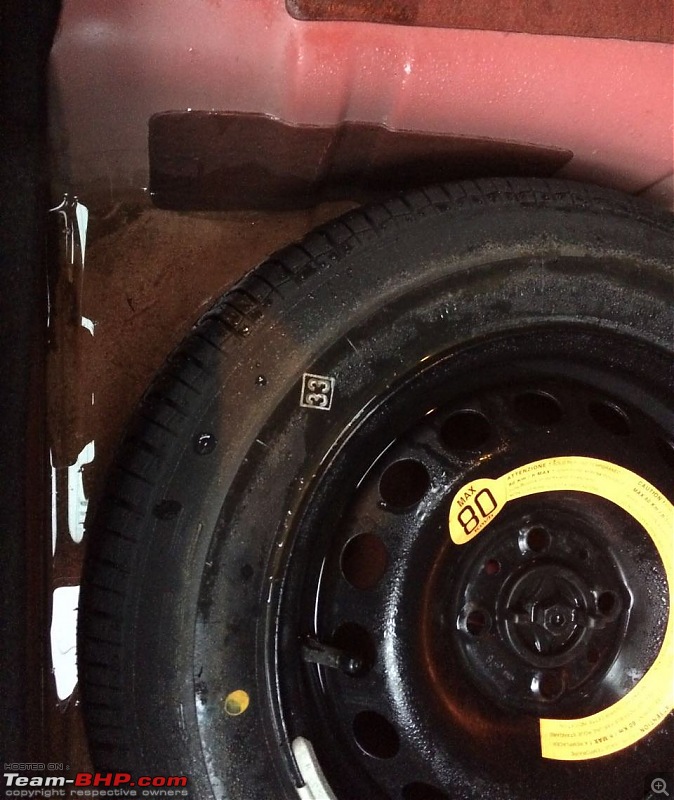 Strange thing about this was that the boot floor was not getting wet. There were no dampening in any of the surrounding places The problem was really tough to replicate at the service centre. Tougher than we thought it would be. After 4 Visits, and many trial and errors, the problem has not resurfaced, but we do not know if it really has been solved After each iteration, the car was washed to check for any water seeepage. every time after the wash, there was no water seepage observed, but after getting the car home, One rain and the water used to come back. Tail lamps, Boot door beading, roof seal, and finally the reverse parking sensor(installed by the dealer) have all been checked and fixed for now. Hopefully the problem is solved Last edited by hemanth.anand : 12th September 2016 at 10:44. |
| |  (4)
Thanks (4)
Thanks
 |
| The following 4 BHPians Thank hemanth.anand for this useful post: | arunphilip, GTO, RavenAvi, vb-saan |
| | #11 | |
| Distinguished - BHPian  | Re: Water Leakage in cars - Causes & solutions Quote:
In such cases like your friends, where a normal wash doesn't help detect the leak, the ideal approach is to hang a hose above the car (say the hatch area) and leave it running for a healthy amount of time. This will simulate an actual rain shower. (For kicks and added realism, you can fit a shower-head type of attachment to the hose  ) )It is often the case that a little water has to collect around a beading or seam, and once the water level exceeds the height of the beading/seam (probably due to a blockage), it will then continuously flow across the beading/seam, transferring large amounts of water. Given the quantity of water shown in the photo, this is what I'd suspect. And that's where soaking a car is useful to detect such tricky issues. Last edited by arunphilip : 12th September 2016 at 11:03. | |
| |  (4)
Thanks (4)
Thanks
 |
| The following 4 BHPians Thank arunphilip for this useful post: | GKMahajan, GTO, RavenAvi, The Rationalist |
| |
| | #12 |
| BANNED Join Date: Apr 2015 Location: Kochi
Posts: 924
Thanked: 7,279 Times
| Re: Water Leakage in cars - Causes & solutions One of my friends had water seepage issue and after numerous failed attempts by service personnel, he did a juggad,a water based dye and pin pointed the leakage. Thinking out of the box can help at times. |
| |  (4)
Thanks (4)
Thanks
 |
| The following 4 BHPians Thank The Rationalist for this useful post: | --gKrish--, arunphilip, GKMahajan, GTO |
| | #13 |
| Senior - BHPian Join Date: Sep 2012 Location: Pune
Posts: 1,061
Thanked: 3,726 Times
| Re: Water Leakage in cars - Causes & solutions Nicely done. I can tell one thing about roof leakages: Dont ever break your windshield. My car's front and rear windscreens were broken in an attempt to rob the car (which failed miserably). Authorised service center did the job of replacing the glass. Unfortunately, it did not rain much in the next two rainy seasons after that (or maybe I did not drive the car in heavy rains). Since last year, the car has started leaking from the front (lamp) when it rains heavily. Driving in moderate rain does not cause any leak though. It happens only when the AC is not ON and its raining heavily. I am guessing it has to do something with difference in inner and outer temperature causing the air to expand and in turn stretching the improperly done seals. I reported this to the A.S.S again but they are denying the reason of poor workmanship and charging a bomb to remove the glass and apply the sealant again. Since monsoons are gone now, I am in no mood to give the car to fix (which I dont know if it will work this time also). Its deeply frustrating. I am thinking of using a glass sealant available on Amazon as a temporary fix in the next monsoon. Folks, Let me know if that works I dont mind even if it is a temporary fix as the car does not leak everytime, it happens only in certain scenarios. One more point worth noting. This time it rained heavily in Pune, I found that some parts in the engine bay were wet. Do take the effort to open the bonnet after driving in heavy rains to see where water is going. I saw the left headlamp wiring was pretty wet and some water had somehow splashed on the battery, the moisture had caused some sulphation at the terminals and rusted the rod and nut that holds the battery. I might even say that it is poor design by Honda of their Brio. Driving the Chevvy Beat in heavy rains and looking at the engine bay, I could not find even a single patch of moisture anywhere. Last edited by NiInJa : 12th September 2016 at 11:44. |
| |  (4)
Thanks (4)
Thanks
 |
| The following 4 BHPians Thank NiInJa for this useful post: | arunphilip, GKMahajan, GTO, uab55 |
| | #14 | |
| BHPian Join Date: Feb 2009 Location: New Delhi
Posts: 154
Thanked: 62 Times
| Re: Water Leakage in cars - Causes & solutions Quote:
http://www.amazon.in/Rust-Oleum-2654...ords=rustoleum Although kindly use proper masking before spraying it. I would recommend to identify the area first! | |
| |  (1)
Thanks (1)
Thanks
 |
| The following BHPian Thanks kcj3b for this useful post: | GTO |
| | #15 |
| Team-BHP Support  | Re: Water Leakage in cars - Causes & solutions Quite an encyclopedia on water leakages, Arun! Thanks for sharing  . . If you own a car that isn't heavily localised and is sold primarily in LHD countries, check the dummy plug (for LHD components on the firewall). My 530d suffered water leakage recently and it was this dummy plug that had gone bad. Created a damn mess inside the cabin. Took all of 7 days to properly dry her out. |
| |  (4)
Thanks (4)
Thanks
 |
| The following 4 BHPians Thank GTO for this useful post: | arunphilip, InControl, The Rationalist, vb-saan |
 |


